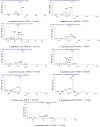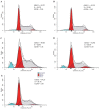Anti-lung cancer activity through enhancement of immunomodulation and induction of cell apoptosis of total triterpenes extracted from Ganoderma luncidum (Leyss. ex Fr.) Karst
- PMID: 23966082
- PMCID: PMC6270046
- DOI: 10.3390/molecules18089966
Anti-lung cancer activity through enhancement of immunomodulation and induction of cell apoptosis of total triterpenes extracted from Ganoderma luncidum (Leyss. ex Fr.) Karst
Abstract
Ganoderma luncidum (Leyss. ex Fr.) Karst. (GLK) has been used traditionally for the prevention and treatment of cancers or tumors for a long time in Traditional Chinese Medicine. The triterpenes as main effective components of GLK have been found to be beneficial for the efficacy. The purpose of this study was to examine the anti-lung cancer activity of triterpenes of GLK in vitro and in vivo and to explore their anti-lung cancer effects and potential mechanisms. A549 cells and Lewis tumor-bearing mice were used to evaluate the inhibition effects of triterpenes on cell proliferation and tumor growth. The IC50 of triterpenes of GLK on A549 cells was 24.63 μg/mL. Triterpenes of GLK could significantly inhibit tumor growth in mice (30, 60 and 120 mg/kg). The immune organs indexes including spleen and thymus were increased remarkedly by the treatment with triterpenes. Moreover, they were able to stimulate the immune response by increasing the expressions of IL-6 and TNF-α. Flow cytometric analysis revealed that cell arrest caused by triterpenes treatment (7.5, 15 and 30 μg/mL) was in the G2/M phase in A549 cells. Triterpenes induced apoptosis by decreasing the expression of the antiapoptotic protein Bcl-2 and pro-caspase 9 and increasing the levels of cleaved-caspase 9. Our findings suggested that the triterpenes of GLK have anti-lung cancer activity in vitro and in vivo via enhancement of immunomodulation and induction of cell apoptosis. The study provides insights into the mechanism of GLK in the prevention and treatment of lung cancer.
Figures








Similar articles
-
Anti-cancer Effects of a Neutral Triterpene Fraction from Ganoderma lucidum and its Active Constituents on SW620 Human Colorectal Cancer Cells.Anticancer Agents Med Chem. 2020;20(2):237-244. doi: 10.2174/1871520619666191015102442. Anticancer Agents Med Chem. 2020. PMID: 31749435
-
A combination of alkaloids and triterpenes of Alstonia scholaris (Linn.) R. Br. leaves enhances immunomodulatory activity in C57BL/6 mice and induces apoptosis in the A549 cell line.Molecules. 2013 Nov 12;18(11):13920-39. doi: 10.3390/molecules181113920. Molecules. 2013. PMID: 24225772 Free PMC article.
-
Interaction of Ganoderma triterpenes with doxorubicin and proteomic characterization of the possible molecular targets of Ganoderma triterpenes.Cancer Sci. 2008 Jul;99(7):1461-70. doi: 10.1111/j.1349-7006.2008.00824.x. Epub 2008 Apr 16. Cancer Sci. 2008. PMID: 18422750 Free PMC article.
-
A comprehensive review of the structure elucidation and biological activity of triterpenoids from Ganoderma spp.Molecules. 2014 Oct 30;19(11):17478-535. doi: 10.3390/molecules191117478. Molecules. 2014. PMID: 25361420 Free PMC article. Review.
-
A Comprehensive Review on the Chemical Composition, Pharmacology and Clinical Applications of Ganoderma.Am J Chin Med. 2023;51(8):1983-2040. doi: 10.1142/S0192415X23500878. Epub 2023 Oct 31. Am J Chin Med. 2023. PMID: 37903715 Review.
Cited by
-
Advances in traditional Chinese herbal medicine and their pharmacodynamic mechanisms in cancer immunoregulation: a narrative review.Transl Cancer Res. 2024 Feb 29;13(2):1166-1187. doi: 10.21037/tcr-23-1983. Epub 2024 Jan 24. Transl Cancer Res. 2024. PMID: 38482437 Free PMC article. Review.
-
Unveiling the Synergistic Effect of Salicylic Acid on Triterpenoid Biosynthesis in Athelia termitophila: Elucidating the Molecular Underpinnings.Int J Mol Sci. 2025 Jan 24;26(3):996. doi: 10.3390/ijms26030996. Int J Mol Sci. 2025. PMID: 39940765 Free PMC article.
-
Ethanolic Extract of Ganoderma mexicanum Pat. Mycelium: A Source of Bioactive Compounds with Antiproliferative Activity and Potential PPAR-γ Natural Ligands.Pharmaceuticals (Basel). 2025 Jun 18;18(6):909. doi: 10.3390/ph18060909. Pharmaceuticals (Basel). 2025. PMID: 40573305 Free PMC article.
-
Ganodermanontriol Suppresses the Progression of Lung Adenocarcinoma by Activating CES2 to Enhance the Metabolism of Mycophenolate Mofetil.J Microbiol Biotechnol. 2024 Feb 28;34(2):249-261. doi: 10.4014/jmb.2306.06020. Epub 2023 Oct 1. J Microbiol Biotechnol. 2024. PMID: 38419324 Free PMC article.
-
Fungal influence on immune cells and inflammatory responses in the tumor microenvironment (Review).Oncol Lett. 2024 Nov 11;29(1):50. doi: 10.3892/ol.2024.14796. eCollection 2025 Jan. Oncol Lett. 2024. PMID: 39564373 Free PMC article. Review.
References
-
- Liu H., Guo Y.Q. Evaluation of immune regulation effects of Chinese medicinal formulae based on immunomics of traditional Chinese medicine. Zhongguo Zhong Yao Za Zhi. 2008;33:2958–2960. - PubMed
Publication types
MeSH terms
Substances
LinkOut - more resources
Full Text Sources
Other Literature Sources

